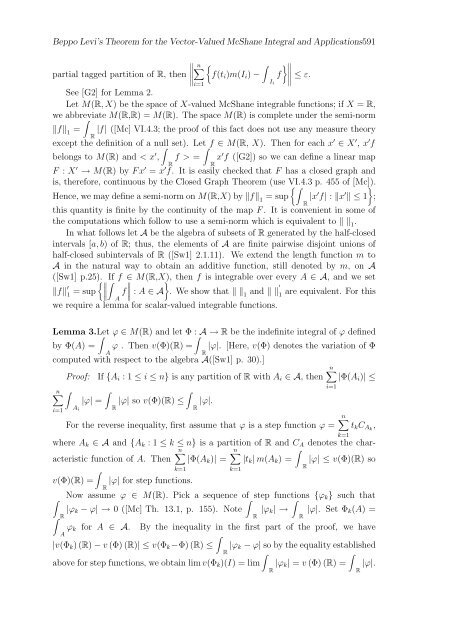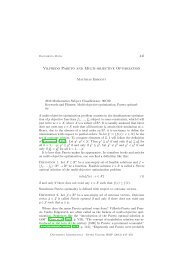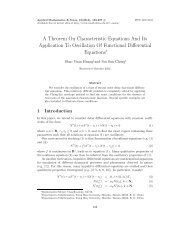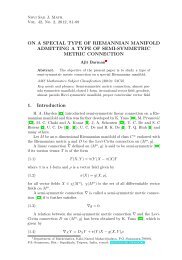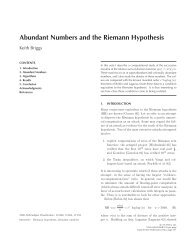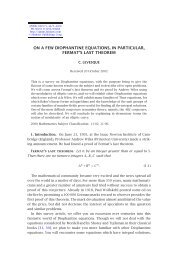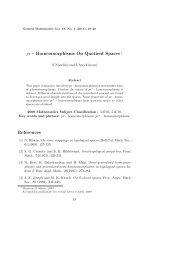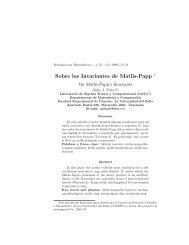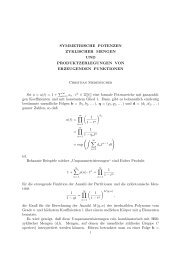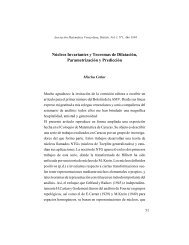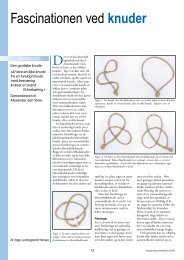Beppo Levi's Theorem for the Vector-Valued McShane Integral and ...
Beppo Levi's Theorem for the Vector-Valued McShane Integral and ...
Beppo Levi's Theorem for the Vector-Valued McShane Integral and ...
You also want an ePaper? Increase the reach of your titles
YUMPU automatically turns print PDFs into web optimized ePapers that Google loves.
<strong>Beppo</strong> Levi’s <strong>Theorem</strong> <strong>for</strong> <strong>the</strong> <strong>Vector</strong>-<strong>Valued</strong> <strong>McShane</strong> <strong>Integral</strong> <strong>and</strong> Applications591<br />
n∑<br />
{<br />
∫ } ∥ ∥∥∥<br />
partial tagged partition of R, <strong>the</strong>n<br />
f(t<br />
∥ i )m(I i ) − f ≤ ε.<br />
i=1<br />
I i<br />
See [G2] <strong>for</strong> Lemma 2.<br />
Let M(R,X)be<strong>the</strong>spaceofX-valued <strong>McShane</strong> integrable functions; if X = R,<br />
we abbreviate ∫ M(R,R) =M(R). The space M(R) is complete under <strong>the</strong> semi-norm<br />
‖f‖ 1<br />
= |f| ([Mc] VI.4.3; <strong>the</strong> proof of this fact does not use any measure <strong>the</strong>ory<br />
R<br />
except <strong>the</strong> definition of a null ∫ set). Let∫<br />
f ∈ M(R, X). Then <strong>for</strong> each x ′ ∈ X ′ , x ′ f<br />
belongs to M(R) <strong>and</strong>= x ′ f ([G2]) so we can define a linear map<br />
R<br />
R<br />
F : X ′ → M(R) byFx ′ = x ′ f. It is easily checked that F has a closed graph <strong>and</strong><br />
is, <strong>the</strong>re<strong>for</strong>e, continuous by <strong>the</strong> Closed Graph <strong>Theorem</strong> (use VI.4.3 p. 455 of [Mc]).<br />
{∫<br />
}<br />
Hence, we may define a semi-norm on M(R,X)by‖f‖ 1<br />
=sup |x ′ f| : ‖x ′ ‖≤1 ;<br />
R<br />
this quantity is finite by <strong>the</strong> continuity of <strong>the</strong> map F . It is convenient in some of<br />
<strong>the</strong> computations which follow to use a semi-norm which is equivalent to ‖‖ 1<br />
.<br />
In what follows let A be <strong>the</strong> algebra of subsets of R generated by <strong>the</strong> half-closed<br />
intervals [a, b) ofR; thus, <strong>the</strong> elements of A are finite pairwise disjoint unions of<br />
half-closed subintervals of R ([Sw1] 2.1.11). We extend <strong>the</strong> length function m to<br />
A in <strong>the</strong> natural way to obtain an additive function, still denoted by m, onA<br />
([Sw1] p.25). {∥∫<br />
If f ∈ M(R,X), } <strong>the</strong>n f is integrable over every A ∈A,<strong>and</strong>weset<br />
∥∥∥<br />
‖f‖ ′ 1 =sup f<br />
∥ : A ∈A . We show that ‖‖ 1<br />
<strong>and</strong> ‖‖ ′ 1<br />
are equivalent. For this<br />
A<br />
we require a lemma <strong>for</strong> scalar-valued integrable functions.<br />
Lemma 3.Let ∫ ϕ ∈ M(R) <strong>and</strong>letΦ:A→R ∫ be <strong>the</strong> indefinite integral of ϕ defined<br />
by Φ(A) = ϕ . Then v(Φ)(R) = |ϕ|. [Here, v(Φ) denotes <strong>the</strong> variation of Φ<br />
A<br />
R<br />
computed with respect to <strong>the</strong> algebra A([Sw1] p. 30).]<br />
n∑<br />
Proof: If {A i :1≤ i ≤ n} is any partition of R with A i ∈A,<strong>the</strong>n |Φ(A i )|≤<br />
i=1<br />
n∑<br />
∫ ∫<br />
∫<br />
|ϕ| = |ϕ| so v(Φ)(R) ≤ |ϕ|.<br />
i=1<br />
A i R<br />
R<br />
n∑<br />
For <strong>the</strong> reverse inequality, first assume that ϕ is a step function ϕ = t k C Ak ,<br />
k=1<br />
where A k ∈A<strong>and</strong> {A k :1≤ k ≤ n} is a partition of R <strong>and</strong> C A denotes <strong>the</strong> characteristic<br />
function of A. Then |Φ(A k )| = |t k | m(A k )= |ϕ| ≤v(Φ)(R) so<br />
n∑<br />
n∑<br />
∫<br />
k=1<br />
k=1<br />
R<br />
∫<br />
v(Φ)(R) = |ϕ| <strong>for</strong> step functions.<br />
R<br />
∫ Now assume ϕ ∈ M(R). Pick a sequence of ∫ step functions ∫ {ϕ k } such that<br />
|ϕ k − ϕ| →0 ([Mc] Th. 13.1, p. 155). Note |ϕ k |→ |ϕ|. Set Φ k (A) =<br />
∫ R<br />
R<br />
R<br />
ϕ k <strong>for</strong> A ∈ A. By <strong>the</strong> inequality in <strong>the</strong> first part of <strong>the</strong> proof, we have<br />
A<br />
∫<br />
|v(Φ k )(R) − v (Φ) (R)| ≤v(Φ k −Φ) (R) ≤ |ϕ k − ϕ| so by <strong>the</strong> equality established<br />
R ∫<br />
∫<br />
above <strong>for</strong> step functions, we obtain lim v(Φ k )(I) = lim |ϕ k | = v (Φ) (R) = |ϕ|.<br />
R<br />
R


